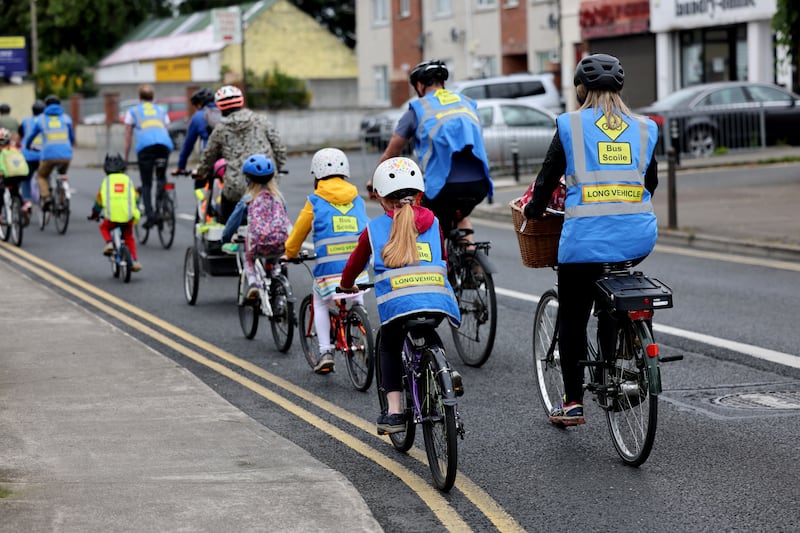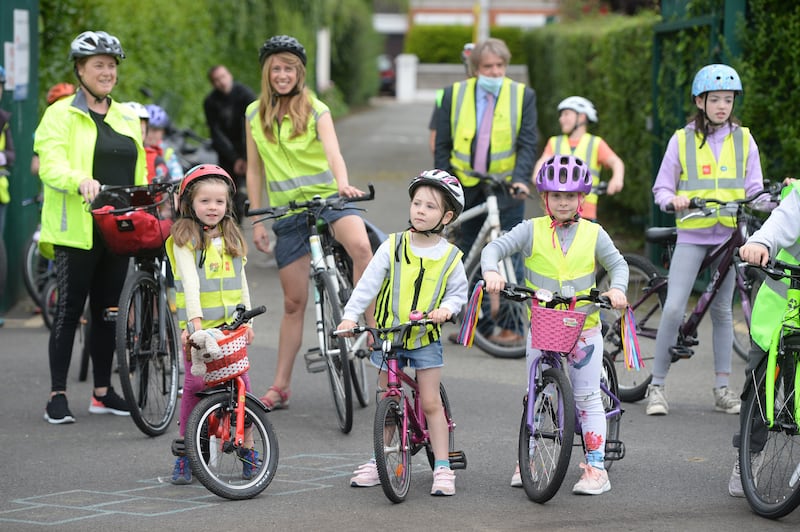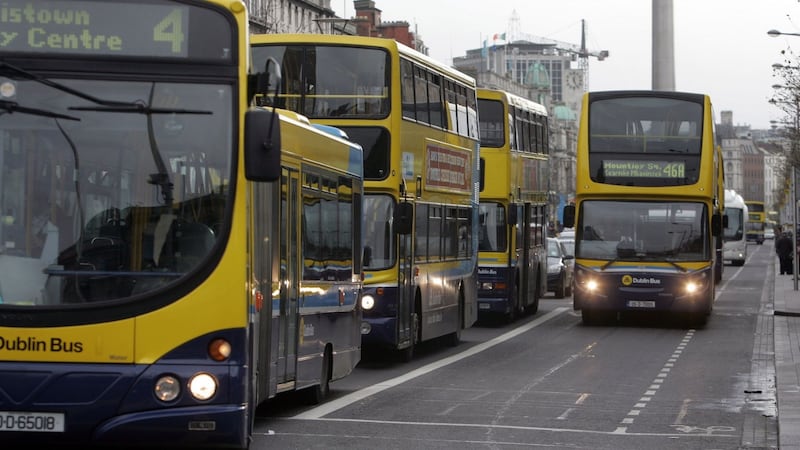Writing in The Irish Times recently, Kathy Sheridan questioned why the roads around primary and secondary schools in Ireland are jammed with cars each weekday morning and afternoon. She questioned why so few arrive to school by foot.
We asked for your views on the subject. Are there valid reasons for children not walking to school? At what age should a child be allowed to walk to and from school by themselves? And what changes would you like to see?
There was a huge response, so, unfortunately, we can only publish an edited selection of the replies. Thank you to everyone who sent a submission.
Here are selection of the replies.
“There is no school transport or safe way for children to get to school in many areas. My husband and I both work full-time. Where we live, school is too far away (two miles) and there is a dangerous national road. Children would definitely not be safe to walk here. That is a fact. I wouldn’t walk on that road. Everyone drives big SUVs to school because that’s what fits bigger families. What option do we have? Outside of Dublin, and other urban areas or towns, this is the reality for many. We can’t all fit into urban areas. It’s not always safe or practical for children to walk. So at our school, we have over a hundred cars and SUVs pulling up outside a small school in a small village where there is no space and no car park. It is so stressful and so dangerous. It is also really damaging to the environment.” – Jill, Co Kildare
“We have two girls in secondary and one boy still in primary. The primary school is rural and there are no footpaths, so all children get driven. The older children walk to school most days (it is approx 1km from our house), however, they often have bags weighing 15kg+, so some days we drive them, as the bags are too heavy. One thing I would say is there is no infrastructure to support walking to school – pedestrians should be prioritised over cars, buses should drop at a convenient location 500-750 metres away from the school in the direction they are coming from, rather than every bus dropping to the door. For me, the way to increase walking is as follows: 1) Embrace technology and find ways for students to be able to do the work required without moving a rainforest of paper [schoolbooks] every day; 2) Put light-controlled crossings on all approaches to the schools and have them set at “pedestrian priority” at school times; 3) Local councils should identify suitable safe drop-off locations on all big routes up to 750m away from the school; 4) Ban all private cars from within 500m of the school at drop-off and collection times. All the above sounds good – until you get to today with 10mm of rain forecast for the time school will be chucking them out.” – Les, Co Cork
“I’d love for my son to walk or cycle to school. The reality is that the nearest multi-d school he was accepted to has ruled us out of the school bus system. An 18km round trip per day, up a rural road, means driving is the only alternative to a five-hour walk.” – Sarah, Co Dublin
“We have just moved from Dublin to Clare. I noticed much more children cycling to school on the traffic-laden roads of Dublin 8 than I do on the rural roads in my coastal town. Cars drive faster on rural roads, speed makes cycling feel less safe. We cycle our two children to school on an electric cargo bike, we are the only family in our school who do this. I’ve noticed a couple of other families who cycle by bike. The majority come by car, I think there are a few reasons for this – lack of footpaths, distance from school, lots of rainy days and parents who are under time pressure to start work.” – Aisling, Co Clare

“1) Irish weather; 2) Parental fear of accidents befalling their children; 3) Many families reside in the countryside – far from school; 4) Some parents have nothing else to do apart from the school runs – it gives a person purpose; 5) If a family spends a lot of money on a car/SUV – no point in having it parked up and idle; 6) Children have to carry a lot of gear including sports gear; 7) Walking may have become an alien activity to many children; 8) Walking is not a healthy activity if a person is breathing noxious fumes from traffic; 9) Parents get a chance to socialise at the school gate; 10) Some parents are house-bound and the school run is an excuse to get out and about; 11) Look at my €100,000 giant chariot that protects my loved ones from all dangers [this is a reference to a Catherine Tate comedy sketch] .” – Ger, Co Limerick
“As a cyclist, I dread back-to-school time, when parents who don’t feel their child will be safe walking or cycling to school bundle them into an SUV with a blind spot the size of a four-year-old child and park it in the cycle lane, forcing me further out in to traffic – excellent. Much safer for everyone.” – Laura, Co Dublin
“We live in a rural area. There are three issues. One is the lack of pavement, so we would have to walk on the road. The second issue is the speed of the traffic, especially on the main road. The third is the size of the lorries which come hurtling round the bends. It’s lethal. We can’t walk it as adults, so it’s certainly no training ground for the kids’ independence. We would encourage them to walk or cycle, but it is simply not an option.” – Mags, Co Cork

“I was one of the kids walking and biking to school in Limerick in the 1980s. In Seattle, my daughter started biking to school age nine. Parents have to be comfortable with bikes, and cycle themselves. Parents of primary school kids who do not cycle themselves do not see it as a safe option to pass on to their kids. It will be much safer for my daughter, when older, to bike after dark rather than walking across a dark campus or car park to a car. Much healthier too and less costly to themselves and society. Parents need to start organising ‘bike trains’ to their local schools. These are very successful in getting kids on bikes in the US and Europe.” – Annemarie, Washington, US
“I walked 600 metres to school as a child in Dublin, alone or with my sister, from age seven or eight. My children, also in Dublin, are accompanied, walking, cycling or scooting 1.5km to school. I expect I will allow my eldest child to walk to school alone when he’s nine. I have trouble understanding the logic of children being driven ever-decreasing distances in ever-increasingly large cars (electric or otherwise). The environment needs us to rethink our behaviour. Our journeys to school are a great opportunity for a stress-free catch-up, watching the change in the seasons. I understand that people are concerned about the danger of traffic, to which I say, stop being part of the problem.” – Emily, Co Dublin
“Simply put, it feels unsafe. We walk our daughter to playschool most days and have to walk past a very large primary school. We would be concerned about letting her walk on her own when she progresses to primary.” – Graham, Co Louth
“I believe this is all down to parents being lazy, plus the lack of school buses that should be able to cater for 50-60 kids per trip. I always see the same parents driving their kids to school, double parking or using disabled spots with their big SUVs they can barely drive. What sort of example are they giving to their own children?” – Leonardo, Co Dublin
“I walk my three young children (age four, six and eight) to school while they scoot, as we’re fortunate to live quite close to their school. However, I have no idea when I’ll feel comfortable letting them walk to school on their own due to safety issues – not with cars but actually with bikes. A year ago my five-year-old was knocked down by a bike and broke his thumb while crossing the road on foot with the green man. This is not an isolated incident – at least a couple of times a week I see cyclists, e-bikes or e-scooters break the pedestrian lights on our way to or from school.” – Aoife, Co Dublin

“I remember my journeys to school in Dublin in the 1960s, travelling by train and foot from suburbs to an inner-city school with my brother. There were dangers then, and few safeguards, but we grew up with an ability and confidence that few eight-year-olds now possess. It will require parents to realise that their children must be let off the leash at some point if they are to develop and, whatever about eight-year-olds, 12- to 18-year-old secondary students should be travelling on their own (or preferably in groups) and not cosseted in cars, causing the traffic chaos we experience now.” – Brian, Co Limerick
“I would love for my children to walk to and from school, and where we live there are safe footpaths the whole way. But the parent does not simply disappear, having deposited the children at the school gate. I must then go to work myself – a 30-minute drive. When I collect them, on my way home from work, we often go directly to an after-school activity that is much further than walking distance away. If the only journey being considered is house-school-house, then the complexity of modern family life is not being accounted for.” – Anna, Co Wicklow
“My daughter is almost 11 (next month) and she is allowed walk home for the past few weeks, one day per week. We live in a small rural village and the school is only a five-seven minute walk from our home. My son aged nine wants to walk, but not until he is 10. My fear is road safety and them being approached by a stranger.” – Martina, Co Tipperary
“While I can appreciate that some people may live a considerable distance away, or have multiple drop-offs or pick-ups during their commute, schools should make an obvious walking zone – a minimum of five minutes and a maximum of 15 minutes away from the school. Studies show that when you incorporate walking into your daily routine, you are more productive for the day ahead. The walking zones will also make the area around the school safer for children as there are less cars around and, as a result, the risk of injury decreases.” – Chloe, Co Dublin
















